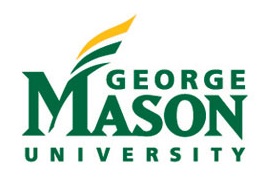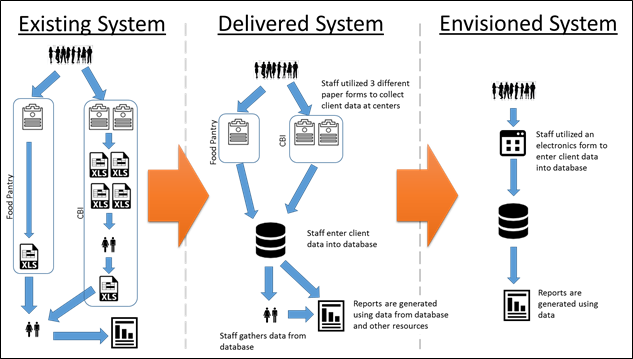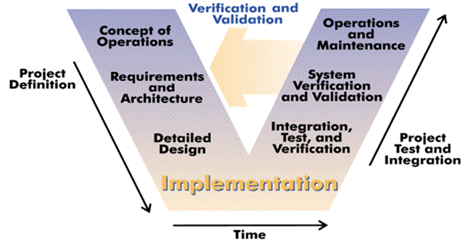 | Cornerstones Unified Database Design ProjectSYST 699: Fall 2014 |  | | | Problem DefinitionThe ClientCornerstones is a nonprofit
organization that promotes self-sufficiency by providing support and advocacy
for those in need of food, shelter, affordable housing, quality childcare, and
other human services. To complete this mission, Cornerstones provides various services
that address these needs. To make the services readily available to their
customers, Cornerstones has organized these services into various program
groups. Of the various divisions within the Cornerstones organization, the
focus of this project will be on the Neighborhood Resources division programs.
The Neighborhood Resources division programs focuses largely on providing food
and community-based initiatives to the local area of Reston.
Neighborhood Resources makes up a
large portion of the clients seen by Cornerstones. The figure below,
taken from Cornerstones’ annual impact report, shows that Neighborhood
Resources accounted for approximately 80% of the clients seen in fiscal year
2014.
Through
early scope definition meetings with Cornerstones, the GMU Team determined that
limiting the scope of this semester’s project to the Neighborhood Resources
programs would be the most effective use of time and resources to complete the
project within the semester’s time frame. Focusing on this division would
provide enough complexity to require a thorough analysis of the program
artifacts, and provide a solution that would make a significant impact to the largest
portion of their business.
Within
the Neighborhood Resources program, there are two main focus areas: (1)
Assistance Services and Pantry Program (ASAPP) and (2) Community Based
Initiative (CBI). ASAPP operates as a local food pantry and provides
packaged food products to those in need. It operates out of one
facility located near Lake Anne in Reston. CBI provides services
through local community resource centers. The focus of the CBI program
is to address specific needs of the community such as building
leadership, self-sufficiency, skills development, child development,
and meeting urgent needs. CBI operates out of five locations in Reston
– Cedar Ridge Community Center, Crescent Community Center, Stonegate
Village Community Center, Southgate Community Center, and Westglade
Club House. The figure below shows the location of each of the
Neighborhood Resources facilities, as well as the central location of
the Cornerstones main corporate office.
The Legacy SystemA
major mechanism for managing the operations that Cornerstones performs
and for reporting results of their efforts is through the tracking of
client data. Cornerstones records client information, demographics,
history of services received, and household information in order to
understand the needs of their clients. The main objective of client
tracking is to answer the following high level questions:
• How much services did we perform?
• How well did we serve our clients?
• Has any of these services improved the overall well-being of our clients?
It
is important to capture this information so that Cornerstones can
understand the impact of the work that they do and report it to their
financial sponsors as well as to local and federal governing bodies.
Also, by accurately determining their effectiveness in improving the
community and its residents, Cornerstones is able to generate more
funding, staff appropriately, and optimize their business functions.
In
the existing system, Cornerstones relies on two main methods for
tracking client data. The first method is pen & paper recording
keeping. Physical applications, or “intake forms”, are used at each of
the program locations to collect client data. These are either filled
out by the clients or completed with the assistance of a Cornerstones
staff member. Depending on the program location, the type of service
received, or community event held, different subsets of data may be
collected. This can range from a simple name and address sign-up sheet
to an in-depth application including personal, household, and
employment history. The pen & paper records are stored in filing
systems at the program location or at central offices. The information
on these forms can also be transferred to an electronic record.
The
method of tracking client data is through electronic spreadsheets. Much
of the data in these spreadsheets comes directly from the paper forms.
The level of completeness of these records vary greatly given that each
location, program, service, or event collects different subsets of the
client data.
From
the individual spreadsheets for each program office, a master
spreadsheet is generated and maintained by Cornerstones staff at the
central Cornerstones office. This master spreadsheet is used to derive
all of the performance, demographic, and statistical analysis that
Cornerstones requires for their reporting processes. The master
spreadsheet is used to calculate specific figures required in their
reports to sponsors and governing agencies.
This overview of the existing system can be summarized in the diagram below:
Problem StatementDue
to the distribution of their programs, varying levels of data
collection, and utilization of multiple and independent spreadsheets,
Cornerstones has experienced difficulty in their client tracking
process. The existing system allows for significant tracking issues.
For example, when a client visits multiple community centers to receive
different kinds of service, Cornerstones may not be able to track
reliably that the same individual is using multiple
services. Reasons for discrepancies in tracking include:
(a) there may be variations in the way the staff member spelled the
clients name, (b) the client may have changed addresses since their
last visit, or (c) the client’s household structure may have changed.
When the records cannot determine the uniqueness of individuals, the
accuracy of the reports may be compromised (i.e. one individual may be
counted as many, or different individuals might be thought to be the
same person). Currently, Cornerstones relies heavily on the staff
members’ familiarity with repeat clients and also on the investigative
abilities of their back-office staff to correct such issues.
In
addition, it is difficult to track a client’s service history.
Cornerstones is interested in knowing how much service is being
rendered to a single individual or family in order to gauge their level
of need. With better tracking, it is hoped that Cornerstone would
be able to identify clients in greater need of service and pro-actively
provide that service. For example, a client who has increased their
need for food pantry services may also need job-finding services or
additional child care assistance. Also, being aware of this history
could prompt Cornerstones staff to recommend nutritional seminars and
counseling to the client. With the current system, this level of
monitoring and response is difficult.
Lastly,
the distribution, inconsistency, and insufficiency of client tracking
in the current system prevents Cornerstones from being able to realize
many additional reporting and analysis capabilities that could greatly
improve their ability to monitor their performance. With a unified,
central database of client records, Cornerstones would be able to
generate many types of reports about their clients, services rendered,
and trends over time.
Our Proposed SolutionThe
objective of this project is develop a robust data strategy and a
unified database design for the Neighborhood Resources division
programs that can help track clients across programs to generate more
effective and accurate reports. The envisioned, final system is a
unified database that can be accessed by all Cornerstones staff from
all locations to support their daily operations. This system will also
support automation of the standard reports that Cornerstones generates
on a periodic basis, and allow the customization of reports for trend
and performance analysis. The unified database will also decrease the
amount of human intervention required to accurately determine client
uniqueness. Instead, each client will be assigned a unique identifier –
developed by this team – which is a combination of their personal
data. The team has determined that collecting three additional
bits of information: the client’s birthdate, the client’s city of birth
and the client’s gender coupled with the information already asked on
the forms (name, address, number of household members, etc.) can be
used to uniquely identify each client.
To
develop a quality system within the time constraints of the semester,
the GMU team will deliver an intermediate phase of this envisioned
system. The intermediate phase will provide a strong foundation needed
to realize the envisioned system. The design and implementation of the
unified database will be completed to support full functionality of
Cornerstones requirements within the Neighborhood Resources division
programs. The figure below displays the transition from the existing
system to our delivered system and then the future work of the
envisioned system.

To
complete this project, the GMU Team followed the systems engineering
lifecycle phases of definition, analysis, design, development,
integration, test, validation, and operation. The definition and
analysis phases consisted of review of the existing forms and reports
used in the Neighborhood Resources division programs, analysis of the
data collected, generation of use cases, and development of
requirements. The design phase was focused on design of the database.
This was divided into three main phases of design – conceptual model,
logical model, and physical model. The integration, test, and
verification focused on the installation of the database and ensuring
that it met all the requirements we developed. Showing successful
adoption of the database by the Cornerstones staff completed the
validation stage. Lastly, delivery and operations of this project
consisted of providing all planning, definition, and design documents
and to the customer so that they will be able to continue operating the
system and prepare for any future work to be completed by the next GMU
team to inherit this project.

|
| Thank you for visiting our page! |
|